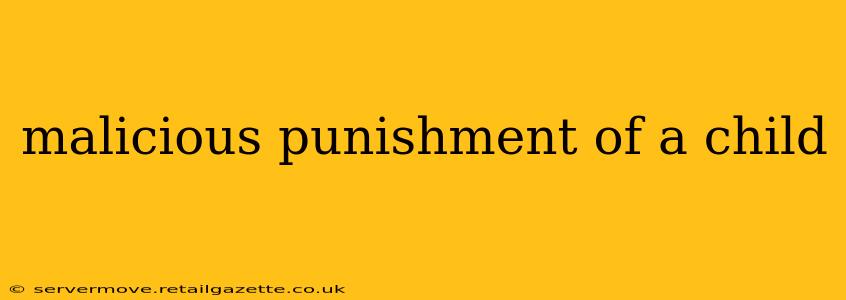Child abuse is a devastating issue, and malicious punishment stands as a particularly harmful form. This isn't about a parent's occasional frustration leading to a stern talking-to; we're talking about deliberate acts designed to inflict pain, suffering, or humiliation on a child. Understanding the signs, recognizing the severity, and knowing how to intervene are crucial steps in protecting vulnerable children.
What Constitutes Malicious Punishment?
Malicious punishment goes far beyond disciplinary measures intended to teach a lesson. It's characterized by actions intended to cause harm, whether physical or emotional. This can include:
-
Physical Abuse: This encompasses hitting, slapping, kicking, burning, shaking, or any other action resulting in physical injury. The severity can range from minor bruises to life-threatening injuries. The intent behind the action is key; an accidental bump is different from a deliberate strike.
-
Emotional Abuse: This is often more subtle but equally damaging. It involves constant criticism, humiliation, threats, intimidation, or isolation. This can severely impact a child's self-esteem, mental health, and emotional development. Examples include name-calling, constant belittling, or withholding love and affection as a punishment.
-
Neglect: While not always considered "punishment," the deliberate withholding of basic needs like food, shelter, clothing, medical care, or education can be a form of malicious neglect, especially if done as a means of control or punishment.
-
Sexual Abuse: This is a severe form of abuse involving any sexual act or behavior directed at a child. It's a crime that can have devastating lifelong consequences.
How Can I Tell if a Child is Experiencing Malicious Punishment?
Recognizing the signs of malicious punishment requires vigilance and awareness. While some signs are obvious, others are more subtle. Look for:
-
Unexplained Injuries: Bruises, cuts, burns, or other injuries that the child cannot explain or that contradict the explanation given by the caregiver.
-
Behavioral Changes: Sudden changes in behavior, such as increased anxiety, withdrawal, aggression, or fear of adults.
-
Fear of Going Home: A child who dreads returning home or expresses fear of a specific caregiver could be a sign of abuse.
-
Self-Harm: Cutting, burning, or other forms of self-harm can be a manifestation of underlying trauma and abuse.
What are the Long-Term Effects of Malicious Punishment?
The consequences of malicious punishment can be profound and long-lasting, affecting various aspects of a child's life:
-
Mental Health Issues: Increased risk of anxiety, depression, PTSD, and other mental health disorders.
-
Behavioral Problems: Aggression, delinquency, and difficulty forming healthy relationships.
-
Physical Health Problems: Physical injuries, chronic pain, and weakened immune system.
-
Substance Abuse: Higher likelihood of substance abuse in adulthood as a coping mechanism.
What should I do if I suspect a child is being maliciously punished?
If you suspect a child is being subjected to malicious punishment, it's crucial to take action. Here's what you can do:
-
Report your concerns: Contact your local child protective services (CPS) or law enforcement agency. Your report could save a child's life. Remember, even if you're unsure, reporting your concerns is always better than doing nothing.
-
Document everything: Keep a record of any observations, including dates, times, and specific details. This information can be vital in investigations.
-
Seek support: Talking to a trusted friend, family member, or therapist can provide emotional support during this difficult time.
What if the malicious punishment isn't physical? How do I identify and address emotional abuse?
Emotional abuse can be harder to detect because it leaves no visible scars. However, its impact is just as severe. Watch for:
-
Low self-esteem: The child may constantly criticize themselves, lack confidence, or believe they are unworthy of love.
-
Anxiety and depression: Excessive worry, sadness, or withdrawal from activities they once enjoyed.
-
Difficulty forming relationships: The child might struggle to build and maintain healthy relationships with peers and adults.
-
Regressive behaviors: Older children may regress to younger behaviors like thumb-sucking or bed-wetting.
Addressing emotional abuse requires a similar approach to physical abuse – reporting to the appropriate authorities and seeking professional help for the child. Therapy can be vital in helping them process the trauma and develop healthy coping mechanisms.
Remember, you are not alone. Many resources are available to help protect children from malicious punishment and support those affected. Taking action can make a world of difference in a child's life.
